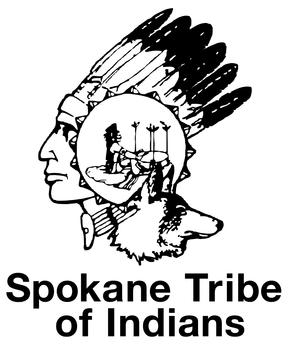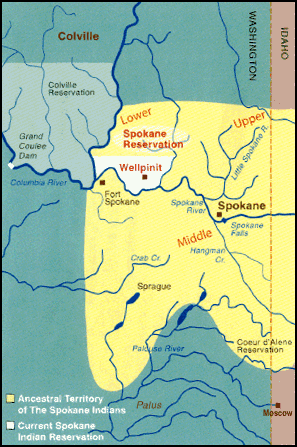what happened to the spokane tribes ancestral land?
| Sqeliz | |
|---|---|
 Spokane tribal logo The electric current Spokane reservation size compared to bequeathed land of the Spokane people. | |
| Full population | |
| (two,708) | |
| Regions with significant populations | |
| | |
| Languages | |
| English, Spokan or Spokane language (dialect of Kalispel-Pend d'Oreille language) | |
| Religion | |
| Dreamer Faith, traditional tribal religion, Christianity | |
| Related ethnic groups | |
| Bitterroot Salish, Coeur D'Alene, Kootenai, Pend d'Oreilles, and other Interior Salish tribes |
The Spokan or Spokane people are a Native American Plateau tribe who inhabited the eastern portion of the Washington state and parts of northern Idaho in the U.s.a. of America. The electric current Spokane Indian Reservation is located in eastern Washington, centered in Wellpinit. The reservation is located almost entirely in Stevens County, but likewise includes two minor parcels of land (totaling nigh 1.52 acres) in Lincoln County, including part of the Spokane River. In total, the reservation is about 615 foursquare kilometers or 237 square miles.
The city of Spokane, Washington takes the tribe'southward name, which ways "children of the Sun" or "Sun People". Spokan or Spokane is a name the Native people gave themselves and one of their native legends says it came from the racket a snake fabricated when a person trounce on a hollow tree where the serpent was hiding. The Spokane language belongs to the Interior Salishan language family. The precontact population of the Spokane people is estimated to exist about 1,400 to 2,500 people. The populations of the tribe began to diminish later contact with settlers and traders due to diseases the Spokane people had never been exposed to previously; thus in 1829 a Hudson Bay trader guessed there were about 700 Spokane people in the area. Populations have been steadily increasing and tribal membership in 1985 was effectually one,961 and in 2000 the U.s. census reported the resident population of the reservation to be around 2,000 people.
Contents
- History
- Organization
- Lifestyle
- Gender Roles
- Organized religion
- Mythology
- Stories
- Creation Story
- Notable tribal members
History
For thousands of years the Spokane people lived near the Spokane River in eastern Washington and northern Idaho surviving by hunting and gathering. Spokane territory once sprawled out over three 1000000 acres (12,000 km²) of country. The Spokane bands were semi nomadic moving around for nine months of the year and settling in permanent winter villages for the other 3. The kickoff contact the Spokane people had with white men was fur traders and explorers. The Lewis and Clark expedition encountered the Spokane tribe in 1805. Already the Spokane people were dwindling in population from introduced diseases like smallpox. Shortly after the encounter with the Lewis and Clark trek fur traders and settlers arrived. In 1810 the North Westward Visitor opened the Spokane House near the confluence of the Spokane and Lilliputian Spokane Rivers every bit a trade mail service. The Spokane Firm was followed by the Pacific Fur Company's Fort Spokane in 1811 which subsequently became a boarding school for the Spokane children from 1898 to 1906. The Spokane Reservation was established in 1881. In 1877 the Lower Spokane people agreed to move to the Spokane Reservation and in 1887 the Upper and Middle Spokane people agreed to move to the Colville Reservation, but non all the Spokane people actually moved from the land causing some conflict with white settlers including the Coeur d' Alene State of war of 1858 when the Spokanes teamed up with the Coeur d'Alenes, Yakimas, Palouses, and Paiutes but remained neutral in the Nez Perce War of 1877 despite pleas from Chief Joseph.
More than recently, around the 1950s uranium was discovered on the reservation and was mined from 1956 to 1962 out of an open pit and from 1969 to 1982 at the Midnite Mine. The now inactive mine is on the list of Superfund cleanup sites with contaminants including metals, radionuclides and acidic drainage. The creation of dams has also impacted the Spokane people. The creation of the Little Falls dam has ended most of the salmon run at Spokane Falls while the Yard Coulee dam concluded all salmon runs on the Spokane River.
System
The Spokane tribe was divided into 3 geographic divisions, upper, lower, and center. Each area was then divided into bands which were composed of groups of related families or kin groups. Individual bands were led past a principal and a sub main who were both selected to lead based on their leadership qualities. Decisions were made by consensus of the group. Unremarkably the married man of a Spokane woman would join his married woman'due south people and although less likely it could become the other fashion. There was mobility between bands, where a person or family unit could spend 1 wintertime with a band and the next winter with another.
Lifestyle
The Spokane diet consisted of fish, local game, and plants. They hunted whitetail deer and mule deer, essential nutrients in the winter. Individual hunters would rails the deer and kill them using a bow and arrow. Fish, especially salmon, were a huge part of the Spokane diet and also a large part of the trade economy. The Spokane people also ate trout and whitefish. These fish would exist smoked or dried for trade or stored for winter. Fish eyes were considered delicacies. Plants gathered by women provided about ½ of the caloric intake for the Spokane tribe.
Gender Roles
Men of the Spokane tribe created tools, fished, hunted and somewhen cared for horses which became essential to the Spokane lifestyle. They were introduced to the Spokane tribe from either the Nez Perce, the Kalispel, or the Flathead tribe. By about 1800 the Spokane tribe was acquiring herds, showing that the utilize of horses was fully in swing for the tribe by and then. Spokane women made coiled baskets out of birch bawl (or out of cedar roots) and likewise wove wallets and numberless from strips of animal hide. They would also stitch mats and other items which were sometimes traded with other Native peoples and white traders and settlers. Women tended to gather plants which consisted of nearly ½ of the Spokane people'due south daily caloric intake. Some of the plants they gathered were camass roots and local berries and barks. The earthworks sticks the women used to gather food was seen as a rite of passage for young girls when they received their first excavation stick. Women'southward graves were often marked with these sticks.
Organized religion
The Spokane religion is The Dreamer Cult, also chosen Washani meaning "worship" or "dancers". The Dreamer Cult is a Plateau Indian faith that emerged from the pressures of colonization. The Washani adult in the Columbia Plateau tribes and was a mix of traditional spirituality and aspects of Christianity. The Dreamer prophets rejected non-Native civilisation and belief systems. the prophets advocated returning to traditional ways of life which "[p]rior to contact, Plateau Indian spirituality revolved around a complex of Winter dances, personal vision quests, and seasonal feasts tied to the almanac subsistence bicycle and the acquisition of guardian spirit powers"(Fisher). A few examples of spiritual dances include The Prophet Trip the light fantastic toe and the Spirit Dance which took identify in mid January where the people involved sought to identify with his spirit. In the Spirit Trip the light fantastic toe a shaman would call upon the spirit to visit an private. It is believed The prophet Smohalla in a vision "foresaw the disappearance of the whites, the resurrection of the Indian dead, and the restoration of the world to a pristine state. This millennial transformation required no acts of violence-indeed, most Dreamers counseled pacifism-but to achieve it the Indians had to obey the instructions of the Creator as conveyed through the prophets"(Fisher). The Dreamer Cult remained prominent within the Columbia Plateau until the early 1890s when the major prophets died and their followers began to lose organized religion in the hope of a world free of white people. The closest contemporary religion to the Washani is the Vii Drums Faith.
Mythology
Stories
- "Spokane Lake of Long Agone" told by Chief Lot
- "The Origin of the Spokane River"
Creation Story
As retold in The Spokane Indians: Children of the Sun
- The Creator, Amotkan fabricated calorie-free only after all the animals had congregated to create it for themselves. The animals showtime erected a high pole and sent Woodpecker up information technology, but the pole was also hot for him. They next sent Coyote upward the pole. But he was as well noisy, all the time shouting down to his children. Deport volunteered, but he constitute information technology too cold atop the pole. The sound of thunder shattered their efforts then. It loosened a piece of red rock, which turned into a handsome cherry-red man. He wanted a blood brother, so Amotkan gave him i fabricated from the root of an herb called spowaunch. The two brothers went to a lodge occupied by a witch, Lady Bullfrog. She became so enamored of the blood brother formed of the root that she leaped onto his confront—and stuck there. In pulling loose, she tore out one of his eyes. He and then volunteered to ascend into the heaven to be low-cal for the earth, for he did not want people to see his face, now missing one centre. Thus, he became the lord's day, and when people looked at him, they had to shut one of their own eyes. The other homo joined his alone brother in the sky. But before he did so, Lady Bullfrog had jumped onto his face, too. He became the moon. Today, if one looks carefully at the moon, one can see Lady Bullfrog clinging to his face.
- Because he was lonesome, Coyote, after several failures, made Spokane man… Coyote and then mixed all these elements together [pitch, clay, hot rock, and reeds] and—adding berries, fume, and fire—created the Spokane man. With these same elements, he created Spokane woman, and Amotkan, the Creator, gave her life. Man and woman soon became wild, caring footling for the safety of the others who had sprung from them. A alluvion came then and covered the state, destroying all except a few people. The survivors banded together for prophylactic, elected a leader, and multiplied. In fourth dimension, the leader divided the people into small groups. They became the various tribes.(Ruby)
Notable tribal members
- Sherman Alexie (Spokane-Coeur d'Alene), author and filmmaker
- Gloria Bird, poet and scholar
- Master Garry, 19th-century tribal leader and diplomat
- Charlene Teters, artist and anti-mascot activist
All content from Kiddle encyclopedia articles (including the article images and facts) tin can exist freely used under Attribution-ShareAlike license, unless stated otherwise. Cite this article:
Spokane people Facts for Kids. Kiddle Encyclopedia.
Source: https://kids.kiddle.co/Spokane_people

0 Response to "what happened to the spokane tribes ancestral land?"
Mag-post ng isang Komento